Financial News
Official Symptoms Of Liver Disease Guide – Alcoholic And Non-Alcoholic
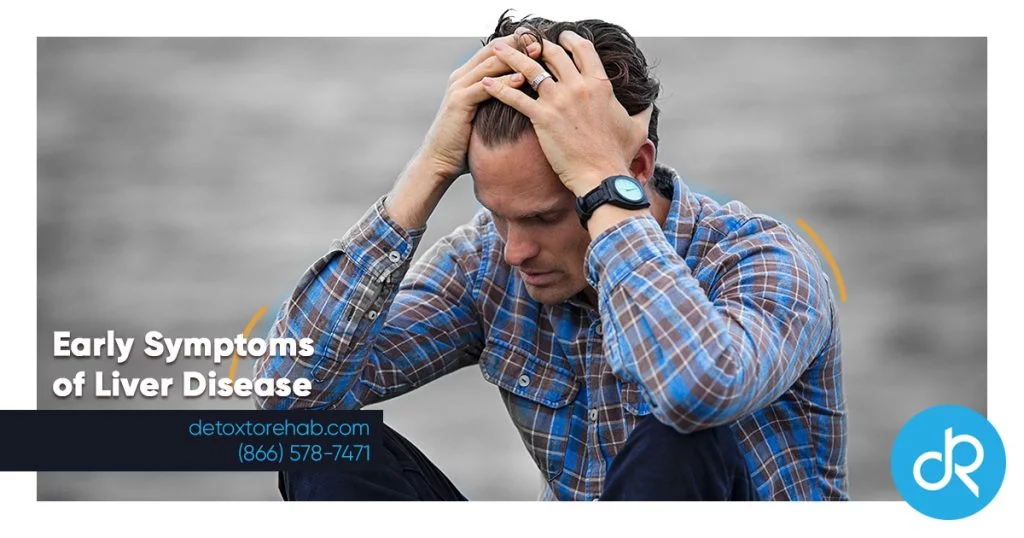 Photo from Envato Elements
Photo from Envato ElementsOriginally Posted On: Official Symptoms Of Liver Disease Guide – Alcoholic And Non-Alcoholic – Detox To Rehab
The liver is one of the most important organs in the body, responsible for over 500 essential tasks. It’s right up there with the heart, lungs, and brain in regard to function importance, yet many people overlook this. That three-pound meaty organ that sits in the upper right quadrant of your belly is always busy filtering blood, detoxifying your body, synthesizing proteins, metabolizing drugs, helping with digesting, as well as helping you avoid diseases.
According to the Center for Disease Control and Prevention (CDC), about 1.8 percent of adults in the U.S. are diagnosed with liver disease (2018). That’s about 4.5 million men and women living with compromised livers.
In addition, many people don’t realize their liver is malfunctioning or diseased because most of the early symptoms are silent. This is why it’s important to learn and recognize the early symptoms of liver disease.
What Is Liver Disease?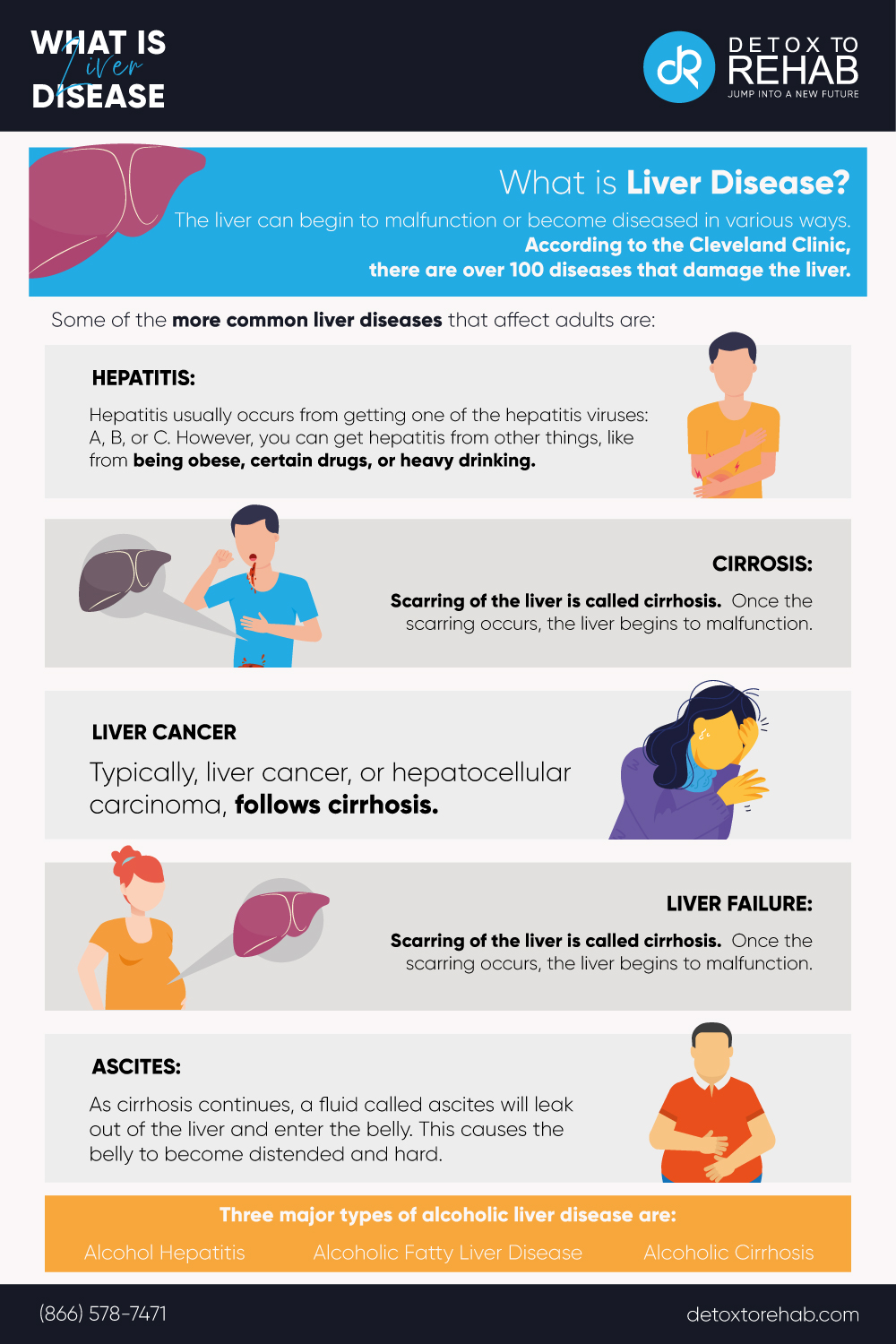
The liver can begin to malfunction or become diseased in various ways. According to the Cleveland Clinic, there are over 100 diseases that damage the liver.
Some of the more common liver diseases that affect adults are:
Hepatitis – Hepatitis usually occurs from getting one of the hepatitis viruses: A, B, or C. However, you can get hepatitis from other things, like from being obese, certain drugs, or heavy drinking.
Cirrhosis – Scarring of the liver is called cirrhosis. Once the scarring occurs, the liver begins to malfunction.
Liver Cancer – Typically, liver cancer, or hepatocellular carcinoma, follows cirrhosis.
Liver Failure – When the liver begins to fail, it’s called liver failure. Causes include heavy drinking, infection, or genetic diseases.
Ascites – As cirrhosis continues, a fluid called ascites will leak out of the liver and enter the belly. This causes the belly to become distended and hard.
Three major types of alcoholic liver disease are:
- Alcoholic Fatty Liver Disease
- Alcohol Hepatitis
- Alcoholic Cirrhosis
For those that consume moderate to heavy amounts of alcohol over a long period of time, the chances of developing alcoholic liver disease increases significantly. For women that drink more than one drink per day and men that drink over two, the likelihood of the alcohol affecting the liver negatively increases quite a bit. The liver is resilient, but the toxins associated with alcohol can damage the liver over time.
Typically, the liver breaks down all sorts of chemicals and removes scar tissue. However, alcohol makes changes to those chemicals, causing a build up of scar tissue. The liver becomes inflamed and scarred, making it sluggish and challenging for it to function at optimal level.
It’s not just chronic, long-term drinking that can prompt alcoholic liver disease either. Some that binge drink for a short period of time can experience liver malfunction symptoms like lethargy or pain in the upper abdomen. Some people think they’re safe from liver damage because they don’t drink every day or maybe only binge drink on the weekends. However, they too put themselves at risk of developing alcoholic liver damage.
Good news associated with early stage alcoholic liver disease is that it may be reversible if the person quits drinking.
If you’re asking, “What are the early symptoms of liver damage?”, it’s essential to learn more about the stages of liver disease.
Early symptoms of alcoholic and non-alcoholic liver disease may be few, as many are essentially silent. However, you may experience:
- Digestive issues like acid reflux or heartburn
- Skin conditions like psoriasis, eczema, or skin itchiness
- Negative medication reactions, as the liver will have a tough time metabolizing them
Let’s go on to look at the various stages of alcoholic liver disease. You’ll get a good idea of early symptoms of liver damage, as well as what happens when it progresses.
Alcoholic Liver Disease: Stages
Those who develop alcoholic liver disease can progress through three main stages if they don’t quit drinking. To get an accurate diagnosis regarding what stage, your doctor will likely order blood work and various tests.
Stage 1: Alcoholic Fatty Liver Disease – In this first stage, fat begins accumulating in the liver due to excess drinking. The amount of drinking is usually moderate to heavy over a period of time. Since this is an early stage, doctors state that those that are diagnosed here can reverse the disease by abstaining from alcohol.
Typically, not many symptoms are felt in this early stage. There may be a tenderness in the liver area or feeling sluggish.
Stage 2: Acute Alcoholic Hepatitis – Continued drinking can cause even more alcoholic liver damage, leading the liver to become inflamed (swollen). This leads right into the second stage of liver disease. Those diagnosed with alcoholic hepatitis are encouraged to quit drinking immediately. Stopping abruptly on your own is not advised, as withdrawal effects can be severe and/or life threatening. It’s advised to stop drinking under the support of your physician or addiction specialist.
The chances of reversing liver damage in this stage can vary depending on the extent of the damage.
Symptoms of the second stage may include:
- No appetite
- Jaundice (yellowing of eyes and skin)
- Tiredness
- Running a low-grade fever
- Tender upper right abdomen
- Nausea
- Vomiting
- If blood work is done for liver function, liver enzymes could be elevated.
Stage 3: Alcoholic Cirrhosis – The third stage of alcohol related liver disease is the most critical. Typically, the liver is damaged beyond repair with heavy scarring from the extent of drinking. However, quitting drinking with support is still advised. It can help prevent more liver damage and help you live a better quality of life.
Progression from the third can lead to liver cancer or end-stage liver failure.
Non-Alcoholic Fatty Liver DiseaseMany people associate liver disease with the overconsumption of alcohol. This is not always the case. Non-alcoholic fatty liver disease (NAFLD) can occur where the liver malfunctions, but it’s not because of alcohol use. Excess fat accumulates in the liver, causing symptoms that are like alcoholic liver disease.
A person with non-alcoholic liver disease will typically go through the same stages as someone with alcohol liver disease. If the condition persists, it can lead to a more serious disease called non-alcoholic steatohepatitis (NASH). The liver cells become quite inflamed and can lead to organ scarring. This can lead to cirrhosis.
There are a range of causes for NAFLD, including diabetes, obesity, inflammation, hepatitis, poison, autoimmune issues, and excess fat in the blood.
The Liver Foundation cites that the most common liver diseases include non-alcoholic fatty liver disease, with a quarter of the U.S. population diagnosed. Risk factors include obesity, alcohol abuse, and hepatitis viruses, which are all preventable factors.
Early Symptoms of Non-Alcoholic Fatty Liver diseaseLearning to recognize early symptoms of non-alcoholic fatty liver disease is important. The earlier one can be diagnosed, the better the prognosis or chances that the liver can reverse some or all the damage.
Just like alcoholic liver disease, the earliest signs of NAFLD may go undetected. It may not be until the person gets into the second or third stage that a diagnosis is made. However, blood tests can flag doctors if liver enzymes are off. This is one reason having yearly bloodwork done by your physician is a good idea.
Early symptoms of NAFLD include:
- Jaundice – the yellowing of the eyes and skin
- Inflammation in abdomen, legs, ankles
- Nausea
- Vomiting
- Urine is dark in color
- Stool is bloody, pale, or dark
- Little appetite
- Feeling overly tired
- Itchy skin
- Easily bruising
Of course, just as with alcoholic liver disease, NAFLD can progress into much more serious liver damage.
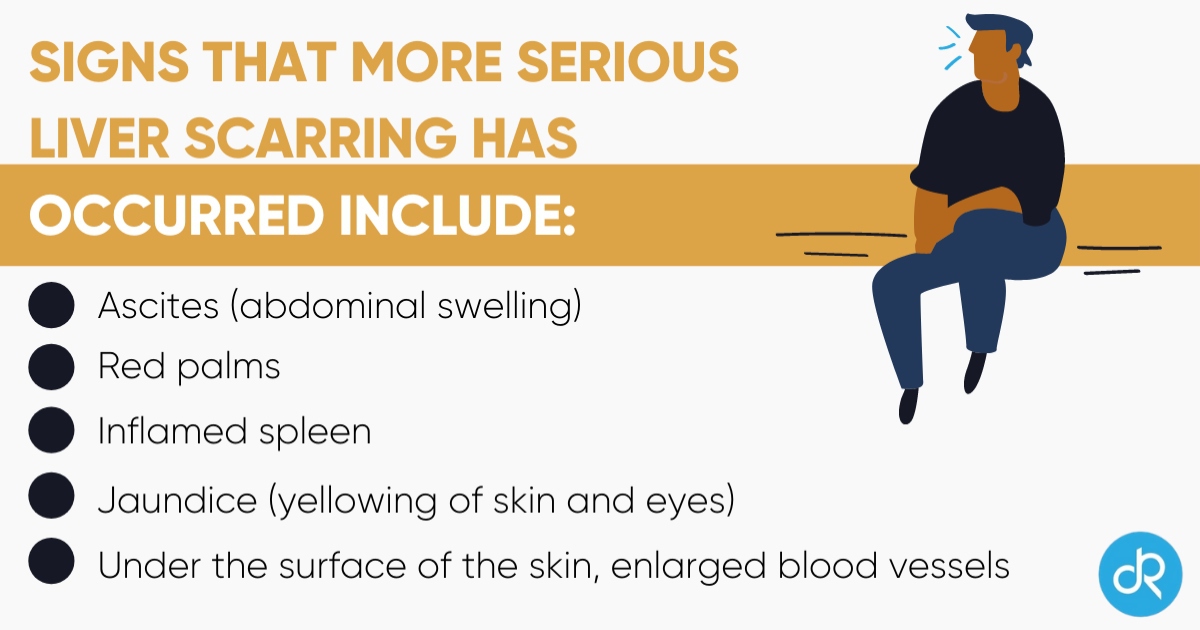
- Ascites (abdominal swelling)
- Red palms
- Inflamed spleen
- Jaundice (yellowing of skin and eyes)
- Under the surface of the skin, enlarged blood vessels
Jaundice is a medical condition where the yellowing of the skin and eyes occur because of high amounts of bilirubin – a bile pigment that is yellowish/orange.
The causes of jaundice vary, including gallstones, hepatitis, and tumors. It’s a quite common symptom of liver disease in adults. For drinkers of alcohol, jaundice may indicate that the progression of liver disease has progressed far. Anyone who develops jaundice and is a drinker is advised to quit drinking with support and seek medical care as soon as possible.
You Need Your Liver To LiveIt’s easy to dismiss your liver, thinking it will just keep doing its functions without problem. However, the liver is far more important than most people know. It’s a critical organ that the body needs to function properly.
Alcoholic liver damage and disease are nothing to play around with. If you are a moderate to heavy drinker, consider quitting drinking so your liver can function at optimal performance.
Early Signs of Liver DamageWe’ve discussed some of the major signs of liver damage. Of course, the degree of damage will vary depending on circumstances. The best way to determine if you have liver damage is to visit your doctor and have them run tests. There’s a lot that can be determined from liver blood tests and/or ultrasounds.
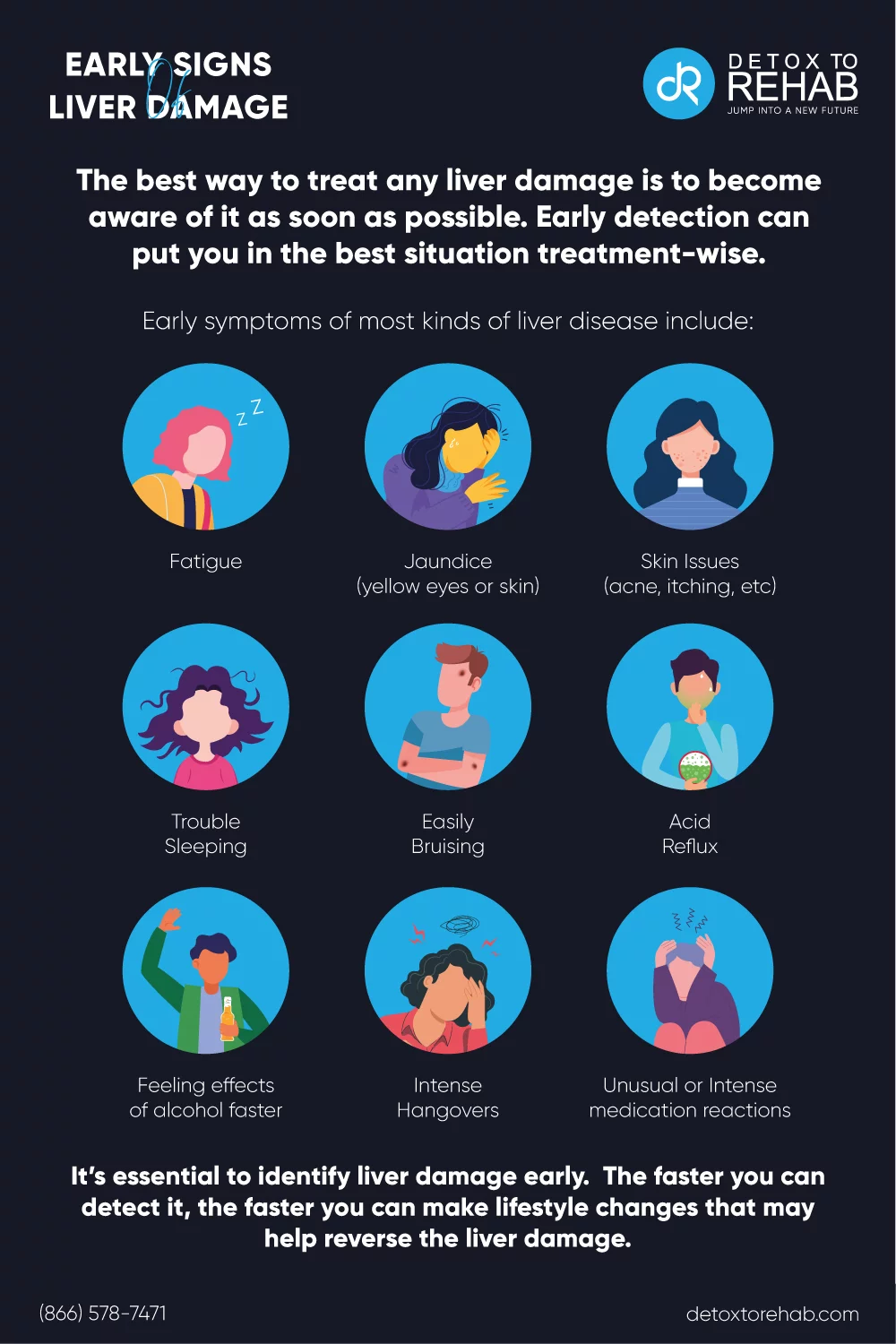
The best way to treat any liver damage is to become aware of it as soon as possible. Early detection can put you in the best situation treatment-wise.
Early symptoms of most kinds of liver disease include:- Fatigue
- Jaundice (yellowing of eyes and skin)
- Skin issues, like itching, psoriasis, eczema, or acne
- Trouble sleeping
- Easily bruising
- Acid reflux
- Feeling the effects of alcohol faster than normal
- Waking up with intense hangovers (due to liver not being able to detoxify well)
- Having unusual or intense medication reactions
It’s essential to identify liver damage early. The faster you can detect it, the faster you can make lifestyle changes that may help reverse the liver damage.
Early Liver Disease: Reach Out For HelpIf you feel you’re experiencing early signs of liver disease, reach out to a physician immediately. They can run blood tests to test the function of your liver.
If you’re a drinker, consider stopping alcohol consumption completely with the support of an addiction recovery specialist.
You can also improve the health of your liver by eating a healthy diet, losing weight if you’re obese, and drinking plenty of filtered water.
If you’re having trouble quitting drinking, reach out to an addiction specialist, inpatient, or outpatient rehab. There are treatments available to treat alcoholism.
Are You Drinking Too Much?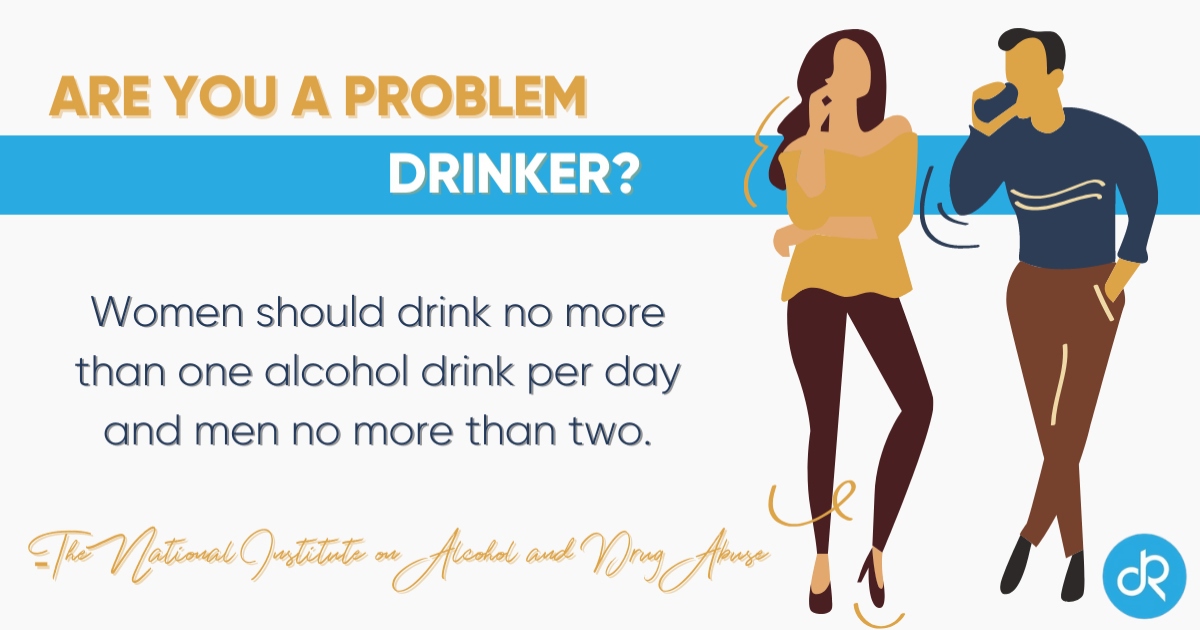
The National Institute on Alcohol and Drug Abuse state that for optimal health, women should drink no more than one alcohol drink per day and men no more than two. Many people drink far more than that and don’t have any idea that they’re indeed drinking too much.
You may someone who is a “problem drinker”. Or perhaps you struggle with alcohol consumption yourself. Those that drink “too much” as considered by the National Institute on Alcohol Abuse and Alcoholism are diagnosed as having “alcohol use disorder”. This is a “chronic relapsing brain disorder” where drinkers have a tough time controlling their alcohol intake despite negative consequences.
According to the Diagnostic and Statistical Manual of Mental Disorders (DSM), various criteria must be met to be diagnosed with AUD. The more criteria met, the more severe the disorder.
Here are some questions to ask yourself to see if you meet any of the criteria:
- Do you drink more than you really want to?
- Have you tried to quit drinking multiple times, only to find yourself drinking again eventually?
- Does drinking cause you to experience negative consequences in your life? (Social, relationships, work, health, finances, school, legal, etc.)
- Do you have cravings for alcohol when you go for a period without it?
- Do loved ones come to you with concern about your drinking?
- Does your drinking cause you to do things you wouldn’t normally do?
- Do you experience blackouts when you drink?
- Has your tolerance increased over time? Whereas you used to be able to get drunk drinking a few drinks, now you have to drink double, triple, or quadruple that to get the same effect.
- Do you find yourself getting withdrawal symptoms when you go for a period without drinking? Things like shaking, intense cravings, anxiety, sweating, etc.?
Alcoholic liver disease is nothing to play around with. If you or someone you know is over-drinking, know that alcohol can cause liver damage – sometimes irreversible damage. Excess fat buildup can cause scar tissue that prevents your liver from working at optimal level.
Learn and recognize the early symptoms of non-alcoholic and alcoholic liver disease. If you show any liver damage symptoms, reach out for help from your physician. In the meantime, get support to stop drinking, adopt a healthy diet, and do your best to manage your weight.
Stock quotes supplied by Barchart
Quotes delayed at least 20 minutes.
By accessing this page, you agree to the following
Privacy Policy and Terms and Conditions.



